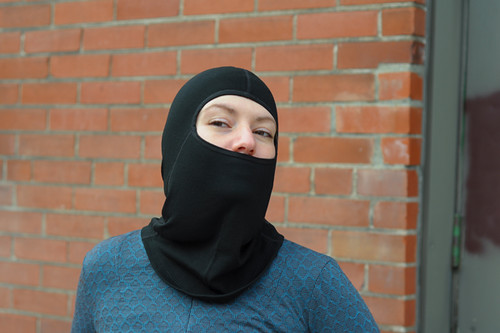Of all the winter cycling accessories out there, none can match the formidable powers of the balaclava. I daresay few garments will make a "cycle chic" photographer withdraw his camera faster. And what other article of clothing is capable of striking fear into bank tellers? As universally unflattering as it is terrifying, the balaclava is not an item one would purchase casually. You've got to get to the point where you really, really need it. For me that point came one December morning. As I pedaled my roadbike against a brutal headwind with temperatures in the 30s, I felt ready to give the dreaded balaclava a try. The one you see here is from Ibex, sent to me for review.
Broadly speaking, a balaclava is a garment that covers the entire head and neck in order to protect the wearer from the cold, exposing only small parts of the face. The Ibex balaclava has an opening for the eyes and nose, but covers the mouth completely. It is form-fitting, closely hugging the contours of the back of the skull, browbone and cheekbones. It is made in the USA of soft and lightweight merino wool (18.5 micron) with flat seams, one size fits all.
My interest in a balaclava is specific to roadcycling. Going at speeds of over 20mph in a leaned-forward position, my face takes the brunt of the harsh winter wind and this can feel extremely uncomfortable. The close fit of the Ibex balaclava is an advantage here: the opening is so tight that it feels almost elasticised; wind does not enter through it while cycling at high speeds. The thin fabric and close fit also make it comfortable to wear under a road helmet when I don one for organised rides: There is no bunching up or slippage. I would say that Ibex's take on the balaclava is designed for athletic activities, such as skiing and winter cycling, rather than for casual wear. Everything stays in its place, and the technical merino fabric forms a tightly woven layer of protection against the wind that feels feather-light and pleasant against the skin.
The inevitable downside of such a precise and form-fitting design, is that there is no versatility in how this garment can be worn. While in some balaclavas the lower portion can be stretched down to expose the mouth or pulled up to cover everything but the eyes, this is not possible with the Ibex version. In order to expose my mouth, I have to stretch the opening forcefully and as soon as I let go my mouth is again covered. Likewise, covering the nose would not be possible. For me that is probably a good thing, because covering my nose with fabric in the past felt constricting and uncomfortable. Even having my mouth covered feels somewhat restrictive and will take some getting used to.
Like most balaclavas, this one is profoundly unflattering - particularly to a face like mine, that becomes all nose and eyebrows once the other features are hidden. So if you're going to rock this, you basically have to not give a straw about how you look for the time being. Also, consider that drivers will be seeing less of your facial features and hair, which, in theory, could interfere with them fully processing you as a real, vulnerable human.
I am not sure yet whether I will be keeping the Ibex balaclava. Current retail price is $30, and I consider that a good deal for a US-made 100% merino product. As a roadcycling-specific garment I think it works well, but the sensation of having my mouth covered might just be out of my comfort zone. Have you worn a balaclava for cycling in the winter? Your thoughts, experiences, and recommendations appreciated.








0 comments:
Post a Comment